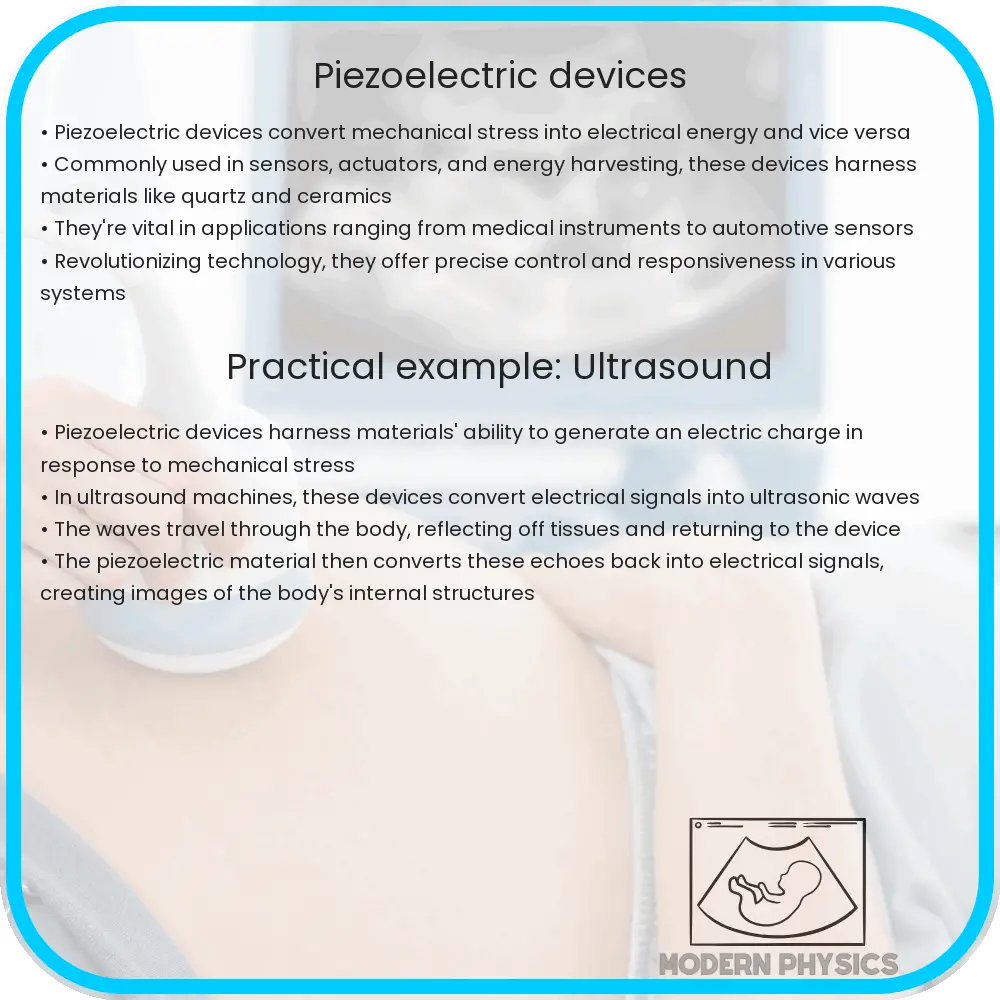An exploration of the piezoelectric effect, focusing on the energy conversion and applications of piezoelectric devices in various industries.

Piezoelectric Devices: An Introduction to Their Efficiency and Applications
Piezoelectric devices harness the piezoelectric effect, which occurs when certain materials generate an electric charge in response to applied mechanical stress. This fascinating interchange between electrical energy and mechanical force not only epitomizes a significant physical principle but also serves as a cornerstone for numerous practical applications in modern technology.
The Efficiency of Piezoelectric Materials
The efficiency of a piezoelectric device is predominantly determined by its ability to convert mechanical energy into electrical energy (and vice versa) with minimal energy loss. The efficiency is quantitatively expressed by the electromechanical coupling factor, k, which is defined as:
k2 = (Stored Electrical Energy) / (Applied Mechanical Energy)
Materials with higher k-values are considered more efficient. Common piezoelectric materials include quartz, Rochelle salt, and various types of ceramics, like lead zirconate titanate (PZT), each offering different efficiency levels based on their intrinsic properties.
Applications of Piezoelectric Devices
Piezoelectric devices find applications across a broad spectrum of industries, illustrating their versatility and utility. Some of the most notable applications include:
- Precision Positioning Systems: Utilized in fields such as semiconductor manufacturing and microscopy, piezoelectric actuators deliver precise control over movement.
- Medical Devices: In medical ultrasound imaging, piezoelectric transducers convert electrical signals into sound waves, and then back into electrical signals to create images of internal organs.
- Energy Harvesting: Piezoelectric materials can convert vibrations from everyday sources like foot traffic or machinery into electrical energy, offering a sustainable way to generate power.
Innovation in Piezoelectric Technology
Recent advances in piezoelectric technology continue to push the boundaries of what these devices can achieve. Innovations often focus on enhancing the materials’ efficiency and widening their application scope. For instance, the development of polymer-based piezoelectric materials provides greater flexibility and durability, expanding their potential uses in wearable technology and soft robotics.
Another exciting area of innovation involves integrating piezoelectric materials with nanotechnology. Nanostructured piezoelectric materials can exhibit enhanced properties like increased surface area and improved sensitivity, which can revolutionize sensor technology and micro-electromechanical systems (MEMS).
As researchers continue to explore and develop new piezoelectric materials and applications, we can anticipate even more innovative and efficient solutions emerging from this dynamic field. This progress promises not only to advance technological capabilities but also to contribute toward more sustainable practices by optimizing energy usage and reducing waste.
Challenges and Future Trends in Piezoelectric Devices
Despite their numerous advantages, piezoelectric devices face some challenges that must be addressed to enhance their applicability further. One key challenge is the brittleness of ceramic piezoelectric materials, which can limit their use in applications requiring high durability and flexibility. Moreover, the high voltage required to operate some piezoelectric devices may not be ideal for portable applications where power efficiency is critical.
To overcome these limitations, ongoing research is focused on developing composite materials that combine the high efficiency of ceramics with the flexibility of polymers. Additionally, efforts are underway to create low-power piezoelectric devices suitable for widespread use in consumer electronics and IoT devices.
Economic and Ecological Impact of Piezoelectric Technology
The adoption of piezoelectric technology also has significant economic and ecological implications. Economically, the ability to harness energy from ambient sources like foot traffic or industrial vibrations can lead to substantial cost savings and open new revenue streams in energy harvesting. Ecologically, piezoelectric devices offer a method to generate electricity without greenhouse gas emissions, aligning with global efforts to promote renewable energy sources and reduce carbon footprints.
Furthermore, as technology advances, the materials used in piezoelectric devices are becoming more environmentally friendly. Researchers are exploring lead-free piezoelectric materials to mitigate the environmental risks associated with lead-based compounds commonly used in current piezoelectric ceramics.
Conclusion
Piezoelectric devices exemplify a remarkable blend of physics and engineering, transforming simple mechanical stress into valuable electrical energy and vice versa. From enhancing the precision of industrial machinery to advancing healthcare diagnostics and promoting sustainable energy solutions, these devices continue to impact a multitude of sectors. As we move forward, the piezoelectric technology stands at the cusp of broader horizons—propelled by innovations that promise greater efficiency, sustainability, and applicability in our daily lives. Embracing these advances, engineers and scientists worldwide are set to redefine what’s possible, making piezoelectric devices an integral part of our technological future.
